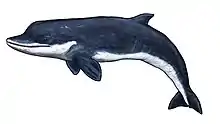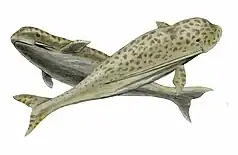| Inermorostrum Temporal range: Early Oligocene, | |
|---|---|
 | |
| Life restoration | |
| Scientific classification | |
| Domain: | Eukaryota |
| Kingdom: | Animalia |
| Phylum: | Chordata |
| Class: | Mammalia |
| Order: | Artiodactyla |
| Infraorder: | Cetacea |
| Family: | †Xenorophidae |
| Genus: | †Inermorostrum Boessenecker et al., 2017 |
| Species: | †I. xenops |
| Binomial name | |
| †Inermorostrum xenops Boessenecker et al., 2017 | |
Inermorostrum is a genus of primitive odontocete from early Oligocene (Rupelian) marine deposits in South Carolina belonging to the family Xenorophidae.
Description and biology
Inermorostrum is largely distinguished from other xenorophiids in having a greatly reduced rostrum devoid of functional teeth. The short, toothless rostrum is unusual for early odontocetes, showing that Inermorostrum mostly preyed on squids and other marine invertebrates by means of suction-feeding.[1]

Inermorostrum anterolateral at Mace Brown Museum of Natural History
References
- ↑ Boessenecker, R.W.; Fraser, D.; et al. (2017). "A toothless dwarf dolphin (Odontoceti: Xenorophidae) points to explosive feeding diversification of modern whales (Neoceti)". Proceedings of the Royal Society B. doi:10.1098/rspb.2017.0531. PMC 5577471.
This article is issued from Wikipedia. The text is licensed under Creative Commons - Attribution - Sharealike. Additional terms may apply for the media files.

